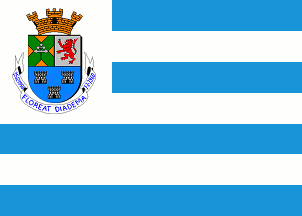 image by Dirk Schönberger,
20 October 2012
image by Dirk Schönberger,
20 October 2012Source: http://pt.wikipedia.org/wiki/Diadema

Last modified: 2012-11-10 by ian macdonald
Keywords: sao paulo | diadema |
Links: FOTW homepage |
search |
disclaimer and copyright |
write us |
mirrors
 image by Dirk Schönberger,
20 October 2012
image by Dirk Schönberger,
20 October 2012
Source:
http://pt.wikipedia.org/wiki/Diadema
Seven horizontal blue and white stripes, with the municipal arms in a white canton four stripes deep.
Official website at
http://www.diadema.sp.gov.br
Dirk Schönberger,
20 October 2012
Diadema is located in a strategic place between the coast (São Vicente) and the hinterland (São Paulo). Until the 1940s, Diadema was made of four settlements belonging to the municipality of São Bernardo - Piraporinha, Eldorado, Taboão and Vila Conceição - served by precarious rods. The establishment in 1925 of the Billings Dam near Eldorado attracted people from São Paulo for recreational purpose. However, Diadema remained a town of little economical significance, being located far away from the Santos-Jundiaí railway, the main trading route of the time. The situation dramatically changed on the 1950s with the industrialization of the region of São Paulo; while multinational companies settled in São Bernardo, smaller companies, oriented to the national market or resupplying the multinational companies, settled in Diadema. The district of Diadema was established on 24 December 1948 by Law No. 233. The struggle for emancipation from São Bernardo was initiated by Conceição. Piraporinha, Taboão, and Eldorado originally disagreed. A plebiscite was organized on 24 December 1958, involving 300 electors settled in Diadema for at least tow years; the emancipation project was validated by a small margin of 46 votes. The municipality of Diadema was established on 18 February 1959 by State Law No. 5,285 and inaugurated on 1 January 1960.
The coat of arms, flag and anthem of Diadema are listed, as "the
symbols representative of the culture and history of the municipality"
and without further description, in Article 9 of the Municipal
Constitution, dated 22 November 2005.
http://www.cmdiadema.sp.gov.br/index.php?p=leis_exibe&ri=1 -
Municipal Constitution
The symbols of Diadema are prescribed by Municipal Law No. 45 of 13 March 1961.
The flag is horizontally divided into four blue stripes, a praise to Our Lady of the Conception, and three white stripes, representing the towns of Conceição, Piraporinha and Eldorado. The municipal arms are placed in a white canton [square, covering four stripes].
The coat of arms, designed by Mayor Evandro Caiaffa Esquível is Per fess, 1a. Or a saltire vert a patriarchal cross argent, 1b. Argent a lion rampant gules, 2. Azure three towers argent. The shield surmounted by a mural crown or. Below the shield a scroll argent inscribed with the motto 'FLOREAT DIADEMA' surrounded by the dates '25-10-1958' and '1-01-1960' all azure."
The green saltire recalls St. Andrew's martyr, while the patriarchal
cross recalls Patriarch St. Bernard.
The loin gules on argent comes from the arms of Martin Afonso da
Souza, the first holder of the Captaincy of São Vicente.
The three towers represent the three towns involved in the struggle
for municipal emancipation, Conceição, Piraporinha and Eldorado. The
blue field recalls the devotion of the locals to Our Lady of the
Immaculate Conception.
The motto means "Diadema flourishes", meaning the growth and blossom
of the town. The dates recall the plebiscite for municipal
emancipation and the inauguration of the municipality, respectively.
The mural crown represents the municipal status.
http://www.diadema.sp.gov.br/cidadao/teste/1782-brasao-municipal-e-bandeira.html - Municipal website
Ivan Sache, 2 November 2012